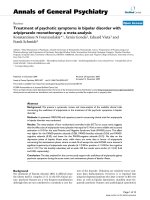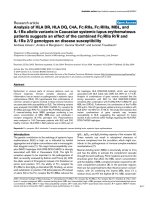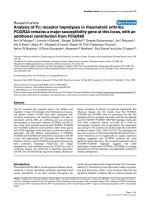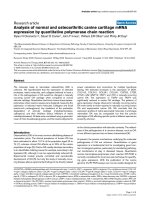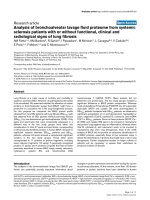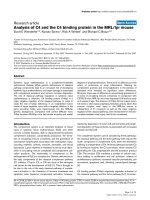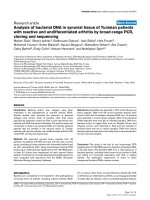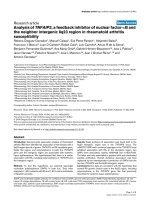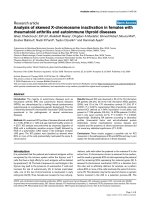Báo cáo y học: " Analysis of 14 BAC sequences from the Aedes aegypti genome: a benchmark for genome annotation and assembly" docx
Bạn đang xem bản rút gọn của tài liệu. Xem và tải ngay bản đầy đủ của tài liệu tại đây (193.4 KB, 12 trang )
Genome Biology 2007, 8:R88
comment reviews reports deposited research refereed research interactions information
Open Access
2007Loboet al.Volume 8, Issue 5, Article R88
Research
Analysis of 14 BAC sequences from the Aedes aegypti genome: a
benchmark for genome annotation and assembly
Neil F Lobo
¤
*
, Kathy S Campbell
¤
†
, Daniel Thaner
*
, Becky deBruyn
*
,
Hean Koo
‡
, William M Gelbart
†
, Brendan J Loftus
‡
, David W Severson
*
and
Frank H Collins
*
Addresses:
*
Center for Global Health and Infectious Diseases, Department of Biological Sciences, University of Notre Dame, Notre Dame, IN
46556-0369, USA.
†
Harvard University, Cambridge, MA 02138, USA.
‡
TIGR, Rockville, MD, 20850, USA.
¤ These authors contributed equally to this work.
Correspondence: Neil F Lobo. Email:
© 2007 Lobo et al.; licensee BioMed Central Ltd.
This is an open access article distributed under the terms of the Creative Commons Attribution License ( which
permits unrestricted use, distribution, and reproduction in any medium, provided the original work is properly cited.
Manual Aedes aegypti genome annotation<p>In order to provide a set of manually curated and annotated sequences from the <it>Aedes aegypti </it>genome, mapped BAC clones encompassing 1.57 Mb were sequenced, assembled and manually annotated using computational gene-finding, EST matches as well as comparative protein homology.</p>
Abstract
Background: Aedes aegypti is the principal vector of yellow fever and dengue viruses throughout
the tropical world. To provide a set of manually curated and annotated sequences from the Ae.
aegypti genome, 14 mapped bacterial artificial chromosome (BAC) clones encompassing 1.57 Mb
were sequenced, assembled and manually annotated using a combination of computational gene-
finding, expressed sequence tag (EST) matches and comparative protein homology. PCR and
sequencing were used to experimentally confirm expression and sequence of a subset of these
transcripts.
Results: Of the 51 manual annotations, 50 and 43 demonstrated a high level of similarity to
Anopheles gambiae and Drosophila melanogaster genes, respectively. Ten of the 12 BAC sequences
with more than one annotated gene exhibited synteny with the A. gambiae genome. Putative
transcripts from eight BAC clones were found in multiple copies (two copies in most cases) in the
Aedes genome assembly, which point to the probable presence of haplotype polymorphisms and/
or misassemblies.
Conclusion: This study not only provides a benchmark set of manually annotated transcripts for
this genome that can be used to assess the quality of the auto-annotation pipeline and the assembly,
but it also looks at the effect of a high repeat content on the genome assembly and annotation
pipeline.
Background
Ae. aegypti is the primary vector for both dengue and yellow
fever viruses. In an effort to better understand this important
disease vector and to provide tools to facilitate new avenues of
research, whole-genome sequencing has been initiated. The
1.3 Gb genome (strain LVP
ib12
) has been sequenced to 8×
Published: 22 May 2007
Genome Biology 2007, 8:R88 (doi:10.1186/gb-2007-8-5-r88)
Received: 21 December 2006
Revised: 4 April 2007
Accepted: 22 May 2007
The electronic version of this article is the complete one and can be
found online at />R88.2 Genome Biology 2007, Volume 8, Issue 5, Article R88 Lobo et al. />Genome Biology 2007, 8:R88
coverage in a joint effort by the Broad Institute [1] and The
Institute for Genomic Research (TIGR) [2]. The trace reads
were assembled with the ARACHNE genome-assembly pack-
age [3] into 4,758 supercontigs (assembly AaegL1). A collab-
orative annotation of the genome by VectorBase and TIGR
has resulted in Genebuild 1.0 (designated AaegL1.1) consist-
ing of 15,419 transcripts [4].
In this era of whole-genome sequencing, assembly and anno-
tation, only a single animal genome - Caenorhabditis elegans
- has been completely sequenced, resulting in five fully con-
tiguous telomere-to-telomere chromosomal sequences with
more than 90% of annotations supported by experimental
evidence [5]. This unusually complete animal genome pro-
vides a solid set of data for the scientific community. At
present, large genomes are usually sequenced as draft ver-
sions, resulting in the automatic production of an assembled
genome. These consist of sets of contigs (contiguous
sequence) that are oriented and ordered (when possible)
across gaps with the sequences from the ends of cloned DNA
(mate pair information) into supercontigs or scaffolds. These
scaffolds are the basis of various analyses such as gene anno-
tation and physical mapping.
Genome assembly can be complicated by the presence of hap-
lotype polymorphisms present in the strain used for genome
sequencing, high repeat content, cloning biases, and regions
that are duplicated in the genome. The genome of D. mela-
nogaster [6] and A. gambiae [7] have been through several
rounds of assembly and gene annotation, which have each
successively resulted in a better and more complete version of
the genome consisting of mapped sequence with fewer gaps
and an improved set of gene models [6-8].
The quality of a genome annotation depends on factors such
as the gene prediction algorithm, the presence of high-quality
comparative data such as expressed sequence tags (ESTs) and
experimentally validated gene models, and effective masking
of repeat and transposon open reading frames (ORFs). The
dataset of gene models used to 'train' the algorithm to the spe-
cific genome is particularly important. Currently, the highest-
quality gene models are those made by expert curators who
manually examine all sources of evidence to make a gene pre-
diction (such as that done with model-organism genomes like
that of Drosophila).
In an effort to provide manually curated regions of the Ae.
aegypti genome that can be used to assess the automatic
annotation of the Aedes genome, we have sequenced, assem-
bled and analyzed 14 bacterial artificial chromosome (BAC)
clones. This study provides a set of high-quality manually
annotated Aedes transcripts that have been compared to the
other sequenced dipteran genomes - A. gambiae and D. mel-
anogaster. This study also addresses issues such as the high
repeat content and the presence of possibly duplicated
regions that may have complicated the assembly of the Aedes
genome.
Results
Assembly
Fourteen BAC clones from an Ae. aegypti genomic library
were isolated using PCR primers specific to single-copy
genetic markers [9]. Shotgun sequences from each BAC were
assembled into scaffolds using both the TIGR assembler [2]
and Seqman [10]. Scaffolds resulting from the different meth-
ods of assembly (see Materials and methods) were consistent
with the others. Mate-pair inconsistencies were usually from
sequences that were in repeat regions of the scaffolds. A small
number of single-copy chimeric clones were observed and
their elimination, along with other mate-pair inconsistencies,
did not change the assembled sequences.
The majority of sequence gaps were filled using primers
designed to the unique sequence flanking gaps. Some primers
designed to close these gaps did not produce any PCR prod-
ucts and sequencing reactions with these primers using the
BAC clones as template terminated at the same region or were
unreadable due to polymerase slippage. All remaining gaps in
the 14 BACs were flanked by highly repetitive sequence.
Assembled BAC sequences were compared with the genome
assembly (BLASTN) to see if they assembled in a similar man-
ner. The gaps present in the BAC clone assemblies were either
coincident with gaps present in the genome assembly or
sequence diverged in the genome assembly when gaps were
not present in the same region (as discussed below).
Contigs from each BAC clone were oriented on the basis of
end sequences and mate-pairs. Three BACs (BAC4, BAC7 and
BAC8) were each assembled into continuous sequences with
no gaps. The remaining BAC sequences assembled into sets of
oriented scaffolds with gaps (arbitrarily replaced by 100 Ns)
(Table 1). The only BAC clones that showed differences with
the assembly made at TIGR were BAC8 and BAC9. Assembled
contigs seem to have been mixed during their assembly and a
careful assembly (using Seqman) separated the two BAC
clones into their respective scaffolds. This was verified with
PCR spanning gaps and comparison to the genome assembly.
The 14 BAC assemblies totaled 1,571,625 bp (approx 0.12% of
the 1.3 Gb genome). The average G+C content of all scaffolds
was 37.75%. Although all the sequences had a G+C around the
average, BAC3 had the lowest at 27% and BAC2 had the high-
est at 47% (see Table 1).
Repeat content
Repeat masking resulted in the masking of approximately
20% of the sequence. As repeat masking here was based on
protein homology, the total sequence consisting of transpo-
son sequence is likely to be higher. Manual annotation and
similarity searches with in silico predictions and EST hits
with transcribed transposon sequences increased the repeat/
Genome Biology 2007, Volume 8, Issue 5, Article R88 Lobo et al. R88.3
comment reviews reports refereed researchdeposited research interactions information
Genome Biology 2007, 8:R88
transposon content to approximately 35%. The Feilai element
[11] was the most common element, comprising approxi-
mately 38% of the repeats. Almost all transposons identified
were retrotransposons.
Gene prediction
In silico gene prediction was performed initially on the raw
assembled scaffolds. A preliminary (BLASTX) analysis of
these predicted transcripts (data not shown) demonstrated
that there was a significant amount of over-prediction, gene-
splitting and incorporation of random and transposon-based
ORFs into gene models. Masking of repeat sequences before
gene prediction reduced the number of gene models and this
dataset was used as evidence for manual annotation.
Gene models predicted by Genscan [12] and FGENESH [13]
before repeat masking often included exons derived from
transposon ORFs. An Aedes gene was often split into two pre-
dictions, with the incorporation of unmasked transposon-
based and other random ORFs. In addition, the ab initio gen-
erated sets of gene models (by Genscan and FGENESH) were
different. However, some predicted exons did match Aedes
ESTs. Several hundred ESTs were identified from the Aedes
database (e < -100) as well as from the Drosophila and
Anopheles datasets (e < -50). A preliminary BLAST analysis
of Aedes ESTs (e = 0.0) demonstrated that a large portion of
them (around 30%) mapped to transposon ORFs.
Manual annotation
The 14 BACs were manually annotated in Apollo [14] using
various tiers of evidence like ESTs and comparison to other
dipteran peptides (see Materials and methods). Transcripts
from the Anopheles and Drosophila genomes were used in
conjunction with Aedes ESTs to limit the number of exons to
those that had similarity to gene models in the other dipteran
genomes. Annotations that did not possess similarity to the
two dipteran genomes were also analyzed to include ORFs
that may be specific to the Aedes genome as well as those that
may have diverged significantly from their Anopheles or Dro-
sophila homologs.
There were a total of 51 manual annotations (Table 2) among
the 14 BAC sequences, with BAC2 having no annotated tran-
scripts. Fifty of 51 manual annotations were found in the Ae.
aegypti 1.0 Genebuild (AaegL1.1) [4] and 41 of these were
identical (see Table 2). The remaining varied in several ways
including differences in the 3' or 5' exon (seven transcripts),
different intron/exon structure (two transcripts) or the anno-
tation was missing in that region of the genome (one tran-
script). In all cases, the differences in the manually annotated
models were based on Aedes EST comparisons, comparisons
to annotations and ESTs in the Drosophila and Anopheles
genome as well as confirmation by sequencing of PCR ampli-
cons in a few cases. A number of transcripts differed in the
length of the 3' or 5 ' UTRs. These differences were usually 10-
20 bp long and not considered discordant with the gene build
unless they differed by entire exons. All annotations had
nucleotide matches in the Aedes genome and most had hits to
Aedes ESTs. The genomic region encompassing BAC11 had
two extra transcripts (AAEL03517 and AAEL02535). A pro-
tein comparison revealed that both genome-annotated tran-
scripts were exons from a rhabdovirus nucleocapsid protein.
These were not included in the list of manual annotations.
To confirm the annotation and expression of a subset of these
annotations, primers were designed to all manually
Table 1
Summary of BAC assemblies
BAC number Name of
BAC
Chromosome arm GenBank accession
number
Genetic marker Scaffolds in
assembly
Total number
of contigs
Length (bp) G+C%
1 ND13I3 2q EF173370 Rpl17A 1 2 82203 38.97
2 ND22N19 2q EF173371
D6L600 1 2 146563 47.09
3 ND22N5 3p EF173372
Mal1 1 2 116923 27.39
4 ND41B18 3p EF173373
LF347 1 1 164547 37.94
5 ND41C6 2q EF173374
VMP-15a3 1 7 89409 38.93
6 ND46O19 2q EF173375
BA67 1 7 114988 38.19
7 ND48J19 2q EF173376
D7 1 1 83496 36.99
8 ND56P6 3q EF173377
Para 1 1 81099 37.14
9 ND67B23 3q EF173378
LF106 2 2 136645 39.29
10 ND83P15 3p EF173379
AEGI28 1 2 76584 35.15
11 105H24 1p EF173366
LF178 1 2 140290 38.43
12 124C17 2q EF173367
LF138 1 8 158121 38.25
13 26O21 2p EF173368
LF342 1 2 87550 37.00
14 92LO9 3p EF173369
LF253 1 3 93207 37.72
The 14 BAC clones were localized to chromosome arms with single-locus genetic markers previously determined.
R88.4 Genome Biology 2007, Volume 8, Issue 5, Article R88 Lobo et al. />Genome Biology 2007, 8:R88
Table 2
Summary of manual annotations
BAC
number
Transcript
number
Aedes
transcript
Supercontig Contig Sequencing
of cDNA
Differences in annotation
between manual
annotation (MA) and gene
build
Replicated transcript in Aedes assembly
Aedes
transcript
Supercontig Contig Notes
1 1 AAEL013103 1.789 24718 - - AAEL014498 1.1137 29191 -
2 AAEL013088 1.789 24718 - - AAEL014499 1.1137 29191 -
3 AAEL013092 1.789 24718 - - AAEL014500 1.1137 29189 -
4 AAEL013582 1.875 25903 Identical Longer 5' in MA AAEL015005 1.1393 31331 5' end of transcript
matched MA
AAEL013099 1.789 24718 3' end of transcript
matched MA
5* AAEL015006 1.1393 31331 Identical - AAEL013097 1.789 24718 Identical to
AAEL013097
AAEL013583 1.875 25903 Identical to
AAEL013583
6 AAEL013098 1.789 24719 - Only 3' coding region lines
up
AAEL013098 1.789 24719 Only 3' coding region
lines up
3 7* AAEL009524 1.403 16729 - - AAEL000392 1.7 624 -
4 8 AAEL008104 1.301 13837 - - - - - -
9 AAEL008110 1.301 13837 Identical Different intron/exon
structure
-
10 AAEL008114 1.301 13837 Identical 3' longer in MA - - - -
11 AAEL008115 1.301 13837 - - - - - -
12 AAEL008103 1.301 13837 Identical - - - - -
13 AAEL008100 1.301 13837 - - - - - -
5 14* AAEL014561 1.1166 29449 Identical - Transcript
missing
1.216 10858 -
15 AAEL014559 1.1166 29447 Identical - AAEL006682 1.216 10863 -
6 16* AAEL014711 1.1232 30069 Identical Different intron/exon
structure
AAEL014491 1.1132 29135 -
17 AAEL014712 1.1232 30070 - - AAEL014495 1.1132 29137 -
18 AAEL014709 1.1232 30070 Identical - AAEL014494 1.1132 29136 -
7 19 AAEL006423 1.204 10417 - - - - - -
20 No
transcript
1.204 10417 - Similar to AAEL003685 - - - -
21* AAEL006424 1.204 10417 Identical - - - - -
22 AAEL006417 1.204 10417 Identical - - - - -
Genome Biology 2007, Volume 8, Issue 5, Article R88 Lobo et al. R88.5
comment reviews reports refereed researchdeposited research interactions information
Genome Biology 2007, 8:R88
8 23* AAEL006019 1.186 9724 Identical - AAEL008297 1.312 14138 -
9 24* AAEL010573 1.488 18854 Identical - AAEL000068 1.1 48 -
25 AAEL010594 1.488 18854 Identical - AAEL000046 1.1 48 -
26 AAEL010587 1.488 18855 Identical - AAEL000020 1.1 48 -
27 AAEL010575 1.488 18855 Identical - AAEL000076 1.1 48 -
28 AAEL000054 1.1 48 - - AAEL010578 1.488 18855 -
29 AAEL010595 1.488 18855 - - - - - -
10 30 AAEL007897 1.288 13401 Identical Extra 3' exon in MA - - - -
31 AAEL007893 1.288 13401 - - - - - -
32 AAEL007907 1.288 13401 - - - - - -
11 33 AAEL002503 1.59 3864 - - - - - -
34 AAEL002532 1.59 3866 Identical 3' exon absent in MA - - - -
35 AAEL002534 1.59 3863 - - - - - -
36 AAEL002523 1.59 3864 - - - - - -
12 37 AAEL001205 1.25 1764 - Longer 5' in MA - - - -
38 AAEL001215 1.25 1764 Identical Longer 3' in MA - - - -
39 AAEL001215 1.25 1764 Identical - - - - -
40 AAEL001198 1.25 1761 - - - - - -
41 AAEL001201 1.25 1764 - - - - - -
42 AAEL001210 1.25 1764 - - - - - -
13 43 AAEL008780 1.348 15270 - - AAEL001693 1.39 2713 -
44 AAEL008781 1.348 15269 - - AAEL001703 1.39 2712 -
45 AAEL008769 1.348 15269 - - AAEL001701 1.39 2711 -
46 AAEL008778 1.348 15269 - - AAEL001681 1.39 2711 -
14 47 AAEL005065 1.140 7865 - - AAEL005223 1.146 8136 -
48 AAEL005085 1.140 7866 - - AAEL005220 1.146 8136 -
49 AEL005237 1.146 8136 - - AAEL005088 1.140 7865 -
50 AAEL005229 1.146 8136 - - AAEL005059 1.140 7865 -
51 AAEL005218 1.146 8136 - - No gene
build
annotation
1.140 7865 -
The 51 manually annotated transcripts (Transcript number) from each BAC clone (BAC number) along with their corresponding transcript (Gene build transcript) from the
gene build (AaegL1) and their location (supercontig, contig) are listed along with cDNA amplicons if sequenced. Transcripts that were replicated in the genome are also listed
along with their corresponding gene build transcript, location and differences with the manual annotation (MA) if any. Manual annotations marked with an asterisk indicate
single-copy cDNA-derived genetic markers used to isolate the BAC.
Table 2 (Continued)
Summary of manual annotations
R88.6 Genome Biology 2007, Volume 8, Issue 5, Article R88 Lobo et al. />Genome Biology 2007, 8:R88
annotated transcripts where the prediction lacked necessary
evidence. PCR was performed on cDNA obtained from all
stages of the mosquito (see Materials and methods). These
sequences were utilized to correct or confirm manual annota-
tions when the curator presented multiple possible gene mod-
els or splice sites for a particular sequence. All 20 amplicons
sequenced were identical to a curated gene model (see Table
2).
Replicated segments
Eight of the 14 BAC clones had annotations present more than
once in the genome assembly. This was unexpected as these
BACs were specifically isolated using validated single-locus
genetic markers [9]. These replicated transcripts present in
AaeL1.1 were virtually identical and usually present along
with the same flanking transcripts in different supercontigs.
To see if intergenic sequence were also replicated, the assem-
bled BAC scaffolds were compared to the Aedes genome
assembly scaffolds containing the identical transcripts.
Though replicated transcripts were virtually identical, inter-
genic/intron sequences were usually identical on one repli-
cate while they varied slightly on the other. These eight blocks
of sequence were present in complete or partially replicated
segments in different parts of the Aedes genome assembly,
with only one replicate possessing identical intergenic
sequence and the rest having slightly variable intergenic
sequences.
Some replicated blocks were 'hybrids' of the BAC clone and
the genomic duplication. This is seen in BAC14, where all five
transcripts are found on two supercontigs in the same order
and structure. Intergenic sequences from the first two tran-
scripts are identical to that on supercont1.140 while the
remaining transcripts have intergenic sequences correspond-
ing to that on supercont1.146. This is also seen with BAC9,
where the last transcript and its intergenic sequence are
found on one scaffold while the remaining transcripts and
their intergenic sequnce correspond to another scaffold - even
though all transcripts are found on both scaffolds.
BAC1 was the most complicated with the five transcripts,
being found on four supercontigs. All transcripts were seen in
supercont1.789 while the remaining usually terminated at the
end of a scaffold or had gaps which did not include all tran-
scripts. These three transcripts were also seen with different
intergenic sequences on supercont1.1137. The fourth tran-
script had the 3' end matching up to this scaffold and the 5'
end on supercont1.393. The fifth transcript was found on
supercont1.1393, whereas a sixth transcript with identical
intergenic sequence was not found in the genome, although
transcripts matching it but with varying intergenic sequence
were found. These replicated regions were usually flanked by
highly repetitive DNA and/or gaps or were present at the end
of a supercontig.
Orthology and synteny
When compared with the Anopheles and Drosophila gene
sets (Table 3), 50 and 43 Aedes transcript annotations had
orthologous transcripts in the Anopheles and Drosophila
gene sets, respectively. The genes from the two other dipteran
genomes that were similar to the manual annotations were
almost always orthologs of each other (determined by recip-
rocal BLASTs) [4]. Although most Aedes annotations had a
one-to-one relationship in the other genomes, some matches
were to genes from multigene families. In some cases, the pri-
mary BLAST match was much better than the rest and in
these cases, an ortholog was postulated. In cases where a
number of transcripts matched the manual annotation with
similar e-values, orthologs could not be predicted. A single
manual annotation did not have any similarity in either
genome, and when compared to other dipteran datasets with
less stringent parameters it demonstrated similarity to an Ae.
albopictus salivary protein.
To compare gene sizes between the two mosquitoes, the
amount of sequence covered by the orthologous genes in
Aedes and Anopheles were compared. Single-exon genes were
usually the same size; however, the size of multiexon genes
was directly proportionate to the number of introns in Aedes.
On average, Aedes genes were about 3.9 times the size of their
Anopheles orthologs. Only one Aedes BAC sequence demon-
strated any degree of synteny with Drosophila. BAC11 had
two adjacent transcripts that were found to be next to each
other in the Drosophila genome. Of the 11 BACs with more
than one annotated transcript, nine sequences demonstrated
synteny with the Anopheles genome. Overall, 38 of the 50
transcripts included in these BACs demonstrated synteny in
10 blocks.
For a summary of each BAC clone assembly and analysis
please see Additional data file 1.
Discussion
Fourteen BAC clones encompassing 1.57 Mb were sequenced,
assembled and analyzed for repeat and gene content. Manual
gene annotations were compared to the Ae. aegypti, A. gam-
biae and D. melanogaster gene sets. A subset of these
annotations had their expression and sequence confirmed
with reverse transcription-PCR (RT-PCR) and sequencing.
This benchmark analysis of the Aedes genome has yielded a
set of manually annotated transcripts that has been validated
with molecular and comparative data. In addition, we have
presented data that may clarify the origin of duplicated tran-
scripts in the genome assembly.
BAC assembly
The quality of these BAC assemblies is critical for a valid
assessment of the genome assembly and the automatic gene-
annotation pipeline. To enable this assessment, each BAC
clone was individually assembled using two assembly algo-
Genome Biology 2007, Volume 8, Issue 5, Article R88 Lobo et al. R88.7
comment reviews reports refereed researchdeposited research interactions information
Genome Biology 2007, 8:R88
rithms and the resulting duplicated assemblies were com-
pared to make sure that contigs were identical. In addition, all
BAC sequences were assembled together to ensure that they
sorted independently into the contigs corresponding to indi-
vidual BAC clones. These stringent assemblies revealed that
the sequence of BAC9 (GenBank: AC149799
), which was sub-
mitted to GenBank before this analysis, had contigs in it that
were from BAC8 (GenBank: AC149798
). A stringent analysis
of these BACs in particular enabled their correct assembly. It
was interesting to note that gaps present in the final BAC
scaffolds were identical to those present in the genome
assembly. We believe that the high repeat content of the
sequence in the remaining gaps produces tertiary structures
that are not conducive to sequencing. A high G+C content
may also contribute to this phenomenon. As a result, we were
unable to close several gaps. The 14 final assemblies were con-
firmed both with PCR, sequencing and a comparison to the
genome assembly.
Repeat content
Assembled and oriented BAC scaffolds were masked for
repeat sequence to characterize the transposon content as
well as to enable a more efficient in silico gene model predic-
tion. Gene-prediction algorithms cannot distinguish transpo-
son ORFs, resulting in their being annotated along with
species-specific ORFs. Resulting gene models may not be
indicative of real genes, as genes could be split, merged or
have extra exons. Initial repeat identification demonstrated
that the Aedes genome has an unusually high repeat content
[15]. Repeat masking [16,17] was performed using multiple
repeat datasets to maximize the number of repeats identified.
An initial analysis of in silico gene annotations derived from
the masked sequences revealed that a number of transposons
were not identified as a result of the incomplete cataloging of
the Aedes transposon dataset. This is seen with BAC2, where
there were no transcripts annotated on the assembled
sequence but gene prediction on repeat-masked sequence
suggested the presence of up to 18 transcripts that are derived
from unmasked transposon ORFs. The high repeat content of
this genome is particularly interesting and impacted on the
sequencing, assembly, in silico and manual annotation pre-
sented in this study. The proper identification of a genome's
repeat content is vital as it impacts on these analyses that
form the basis of genomic studies.
Manual annotation and RT-PCR
Manually curated genes are generally considered to be the
highest tier of gene models for genome annotation and train-
ing datasets. Annotations were based on several sets of data
that include manual inspection of species-specific ESTs and
comparative data. A portion of the ESTs mapped to trans-
posons, complicating the manual annotation. These transpo-
son-related ESTs can be attributed either to active
transposition or to genome-related transposition silencing.
As a result, in silico gene prediction on unmasked sequence
resulted in a higher number of predicted genes (around 4
times more), while the presence of unidentified repeat
sequences on masked sequence resulted in over-prediction as
well. Although most of the ORFs from the 51 final manually
annotated gene models were present in these predictions,
transposons present in intergenic sequences led to the split-
ting and merging of exons along with transposon ORFs.
Though the resulting gene predictions from the two ab initio
gene-prediction programs were not alike, they did capture
similar exons. These in silico predicted exons were helpful in
determining splice sites, along with EST and comparative evi-
dence during manual annotation. The large repeat content in
this genome highlights the importance of proper repeat iden-
tification and masking before gene prediction in annotation
pipelines.
Gene models (see Table 2) were predicted only if they had
supporting EST and comparative evidence and did not over-
lap with sequence that was homologous to transposons. We
do not believe we have eliminated any 'domesticated' trans-
posons, although this remains a possibility.
PCR performed on a cDNA library confirmed expression of a
subset of transcripts, enabled a sequence comparison of the
expressed transcripts with the manual annotations and also
introduced an annotation quality-control step. To enable the
most thorough expression analysis, the cDNA library was
derived from RNA extracted from all stages of mosquito
development (see Materials and methods). This molecular
verification points to the importance of manual annotations
in a genome-annotation pipeline that can not only verify the
quality of the auto-annotation but also provide a set of high-
quality transcripts that can be used to develop and improve it.
Comparison of gene models to the Aedes gene build
All manual annotations were compared to the Aedes genome
assembly and Genebuild - AaegL1.1 (see Table 2). Almost all
manually annotated transcripts were found in the Aedes gene
build. Differences between the manually annotated models
and the transcripts from the gene build included a transcript
missing, extra transcripts in the gene build and differences in
annotation (see Table 3). When looking at nucleotide similar-
ity (BLASTN), only one transcript on BAC7 (number 20, see
Tables 2, 3) did not have a match in the gene build, even
though it had perfect nucleotide match in the genome. This
annotation belonged to a multigene family (histone H3) and
had several almost identical annotated transcripts elsewhere
in the Aedes genome. The sequence flanking this gene model
consisted of transposon sequence, and the entire region was
labeled as repetitive in the genome assembly [4]. This tran-
script, present in multiple copies in the genome as well as
being flanked by transposon sequence, was masked before
mapping of ESTs to the assembled genome and consequent
gene annotation. This points to the importance of differenti-
ating multicopy gene sequences versus those that are homol-
ogous to transposons and to the necessity of a comprehensive
catalog of the Aedes transposon dataset.
R88.8 Genome Biology 2007, Volume 8, Issue 5, Article R88 Lobo et al. />Genome Biology 2007, 8:R88
Table 3
Orthology and synteny with Anopheles gambiae and Drosophila melanogaster
Aedes aegypti Anopheles gambiae Drosophila melanogaster
BAC
number
Transcript
number
Aedes
transcripts
Ortholog E-value Chromosome Syntenic
block
Ortholog E-value Syntenic
block
1 1 AAEL013103 ENSANGG00000021076 3.8E-133 3R-37D Yes CG31938 9.5E-094
2 AAEL013088 ENSANGG00000026626 5.5E-009 3R-37D Yes - - -
3 AAEL013092 ENSANGG00000011837 0.0E+0.0 3R-37D Yes CG10413 0.0E+0.0 -
4 AAEL013582 ENSANGG00000023798 1.1E-035 3R-37D Yes CG11247 1.1E-128 -
5 AAEL015006 ENSANGG00000011941 1E-106 3R-37D Yes CG3661 2.2E-104 -
6 AAEL013098 ENSANGG00000002369 0.0E+0.0 3R-37D Yes CG7961 0.0E+0.0 -
3 7 AAEL009524 ENSANGG00000015193 7.3E-281 2R-10C NA CG8696 7.2E-226 NA
4 8 AAEL008104 1 to many 9.4E-058 GW - 1 to many 8.7E-040 -
9 AAEL008110 ENSANGG00000011807 3E-154 2R-12B Yes CG4832 2.5E-078 -
10 AAEL008114 ENSANGG00000009472 4.4E-037 GW - CG12752 1.6E-026 -
11 AAEL008115 ENSANGG00000011761 2.2E-108 2R-12B Yes CG11025 3.2E-037 -
12 AAEL008103 ENSANGG0000012462 7.90E-061 2R-12B - CG7808 2.8E-073 -
13 AAEL008100 ENSANGG00000009215 1.4E-053 2R-8B - CG1078 3E-040 -
5 14 AAEL014561 ENSANGG00000022738 3.0E-009 3R-32C - - - -
15 AAEL014559 ENSANGG00000010922/ENSANGG00000022179 3.3E-068 3R-35C - - - -
6 16 AAEL014711 ENSANGG00000005482 0.0E+0.0 3R-29B Yes CG8815 0.0E+0.0 -
17 AAEL014712 ENSANGG00000022484 8.9E-199 3R-29B Yes CG15084 8.3E-170 -
18 AAEL014709 ENSANGG00000007515 0.0E+0.0 3R-29B Yes CG15100 0.0E+0.0 -
7 19 AAEL006423 ENSANGG00000020489 1.1E-006 2L-20C - CG40120 6.1E-006 -
20 No transcript ENSANGG00000011708 3.5E-026 GW - CG33803 6.9E-028 -
21 AAEL006424 ENSANGG00000027449 3.0E-062 3R-30C Yes - - -
22 AAEL006417 ENSANGG00000020969 2.6E-056 3R-30C Yes - - -
8 23 AAEL006019 ENSANGG00000025048 8.0E-073 2L-20C NA CG9907 8.9E-174 NA
9 24 AAEL010573 ENSANGG00000015129 3.6E-060 2R-19B Yes CG6684 2E-050 -
25 AAEL010594 ENSANGG00000014580 3.7E-107 2R-19B Yes CG32418 2E-032 -
Genome Biology 2007, Volume 8, Issue 5, Article R88 Lobo et al. R88.9
comment reviews reports refereed researchdeposited research interactions information
Genome Biology 2007, 8:R88
26 AAEL010587 ENSANGG00000014498 2E-192 2R-19B Yes CG9590 1E-083 -
27 AAEL010575 ENSANGG00000014455 2E-192 2R-19B Yes CG11837 3.6E-196 -
28 AAEL000054 ENSANGG00000002208 0.0E+0.0 2R-12E - CG8651 0.0E+0.0 -
29 AAEL010595 ENSANGG00000010690 0.0E+0.0 2L-26A - CG16982 1.7E-240 -
10 30 AAEL007897 ENSANGG0000016631 5.1E-194 3R-29B Yes CG14928 6E-164 -
31 AAEL007893 ENSANGG00000018850 1.3E-175 2R-12C - CG31548 2.3E-137 -
32 AAEL007907 ENSANGG00000015978 1.7E-200 3R-29B Yes CG4629 1.3E-144 -
11 33 AAEL002503 ENSANGG00000015084 3.8E-092 X-1B Yes CG1989 3E-082 Yes
34 AAEL002532 ENSANGG00000015036 4.4E-250 X-1B Yes CG3707 6.3E-285 -
35 AAEL002534 ENSANGG00000012432 6.5E-186 X-5C - CG17521 1.9E-167 Yes
36 AAEL002523 ENSANGG00000015081 7.3E-065 X-1B Yes CG1660 6.8E-051 -
12 37 AAEL001205 ENSANGP00000016497 0.0E+0.0 3R-33B - CG4244 0.0E+0.0 -
38 AAEL001215 SNAP_00000004435 9.9E-123 3R-33B Yes CG4230 2E-055 -
39 AAEL001215 ENSANGP00000023803 0.0E+0.0 3R-33B Yes CG7269 1.2E-299 -
40 AAEL001198 ENSANGP00000023805 0.0E+0.0 3R-29B - CG8451 4E-236 -
41 AAEL001201 ENSANGP00000016633 9.8E-041 3R-33B Yes - - -
42 AAEL001210 ENSANGP00000016606 1.9E-060 3R-33B Yes CG8680 2.3E-052 -
13 43 AAEL008780 ENSANGP00000021694 1.9E-079 2L-21C Yes CG2071/
CG1304
3.1E-058 -
44 AAEL008781 ENSANGP00000021694 4.6E-071 2L-21C Yes CG2071/
CG1304
3.5E-048 -
45 AAEL008769 ENSANGP00000021694 1.9E-088 2L-21C Yes CG2071/
CG1304
1.1E-064 -
46 AAEL008778 ENSANGP00000021867 1.6E-103 2L-21C Yes - - -
14 47 AAEL005065 ENSANGP00000018910 6E-159 2R-16C Yes CG6746 3.7E-134 -
48 AAEL005085 ENSANGP00000018909 6.3E-084 2R-16C Yes CG10652 2.5E-078 -
49 AEL005237 ENSANGP00000018845 4.9E-130 2R-16C Yes CG1298 2.4E-095 -
50 AAEL005229 ENSANGP00000019493 3.7E-122 2R-16C Yes CG6746 8.3E-090 -
51 AAEL005218 ENSANGG00000016433 7.7E-151 2R-16B Yes CG10624 1.9E-121 -
Orthology was determined for each transcript from all 14 BACs. The presence of synteny was also determined for orthologous blocks of transcripts when more than one
transcript was present on the BAC clone.
Table 3 (Continued)
Orthology and synteny with Anopheles gambiae and Drosophila melanogaster
R88.10 Genome Biology 2007, Volume 8, Issue 5, Article R88 Lobo et al. />Genome Biology 2007, 8:R88
This set of manually annotated transcripts enables a quality
check of the Aedes genome auto-annotation. Approximately
12% of the manually annotated transcripts possessed minor
differences from their auto-annotation counterparts, indicat-
ing a high-quality genome annotation effort. These differ-
ences, as well as the identification of a rhabdovirus
nucleocapsid incorporation, highlights the importance of
manual annotation and points to a few issues an auto-anno-
tation pipeline may have.
Replicated BAC transcripts in genome assembly
The 14 BACs were identified from single-locus genetic mark-
ers [9]. However, eight of these blocks of genomic sequence
possessed transcripts (including the single-copy markers)
that were replicated in the genome assembly, along with
flanking transcripts, in the same order and structure (see
Table 2). A further analysis of the single-copy genetic markers
in Severson et al. [9], reveals that 26 of the 146 single-copy
genetic markers used are present more than once in the
genome assembly (data not shown). The high percentage of
repeated single-copy markers from a well-known study
presents the possibility that these duplicated assembly
regions may have resulted from actual segmental duplica-
tions, haplotype polymorphisms or misassemblies.
If these regions represented segmental duplications, they
would have to be physically close to each other - as the genetic
markers have been extensively used and the genetic positions
calculated have been well characterized and fall out as one
genetic locus [9]. However, the genome assembly has these
repeated single-copy markers sometimes localizing to differ-
ent supercontigs (suggesting a greater distance between
them). These different supercontigs sometimes also have
markers on them that localize to different linkage groups.
This suggests that even though there may be a number of
repeated markers present close to each other, a certain degree
of misassembly would explain how a single-copy genetic
marker would be duplicated on another supercontig or
present along with a genetic marker from another linkage
group. These events can be explained by the high repeat con-
tent of this genome and the presence of repeats flanking these
regions, further complicating their proper assembly. It was
interesting to note that shotgun sequences from identical
repeats were some of the only discrepancies in our assemblies
in this study. However, the relatively small size of these
assemblies enabled us to completely assemble the BACs
correctly.
If these regions represent haplotype polymorphic regions,
they should demonstrate genetic drift and therefore a certain
amount of sequence variation. These differences would result
in the haplotype regions assembling into two scaffolds and
therefore complicating the assembly. This phenomenon is
seen in polymorphic regions of the A. gambiae genome (dem-
onstrating 95-99% similarity) that assembled independently
of each other ([4,8] and R. Bruggner and M. Hammond, per-
sonal communication). Strains used for sequencing are usu-
ally inbred to eliminate usual genomic variation to enable an
easier assembly and analysis (the strain of Ae. aegypti used
for genome sequencing (LVP
ib12
) was inbred for 12 genera-
tions from an already inbred strain). However, this cannot
eliminate the presence of balanced polymorphisms where
homozygous regions result in lethality - a phenomenon exten-
sively used in Drosophila genetics. Haplotype polymorphic
regions are expected in genome assemblies; however, their
negative effects on assembly and analysis can be minimized
by proper strain selection and inbreeding. The replicated
regions seen here were not precise duplications, as a compar-
ison of the entire nucleotide sequence revealed intergenic dif-
ferences between the replicated blocks. A comparative
analysis revealed that 23 of the 28 transcripts encompassed
by these 'replicated' BACs were single copy in both the A.
gambiae and D. melanogaster genomes, again suggesting a
single-copy nature. The variation seen between replicated
regions, the 'hybrid' nature seen between the BAC sequence
and the genomic replicates, the characterization of the mark-
ers and encompassed genes as being single copy in Aedes [9],
as well as in Anopheles and Drosophila, lead us to believe that
these replicated regions in the genome assembly represent
polymorphic haplotypes coupled with some misassembly
resulting from flanking repeat sequence. There remains the
possibility that some of these regions are actually duplicated
in the genome and are present close to each other.
The replication of an unusually high percentage of genomic
blocks experimentally shown to contain single-copy
sequences (57% (8 of 14)), indicates the presence of an assem-
bly issue which affects the number of gene predictions in the
gene build and the relation of various scaffolds to each other.
This phenomenon also emphasizes the importance of strain
selection and proper inbreeding to enable an easier genome
assembly. The proper characterization of these probable hap-
lotype regions would enable a better genome assembly and
mapping of scaffolds to linkage groups.
Similarity to Drosophila and Anopheles
All manually annotated transcripts were compared to the
Drosophila and Anopheles gene sets (see Table 3). Only one
annotation (number 19) did not show homology to Anopheles
or Drosophila proteins with the search parameters used. This
transcript did demonstrate similarity to an Aedes salivary
protein (D7cclu23-like salivary protein). When the search
parameters were relaxed, the primary hit to Anopheles is an
odorant-binding protein (OBP49). A salivary- or odorant-
related gene would be expected to have significantly diverged
from Anopheles and even further diverged from Drosophila
homologs and would not show a high degree or any similarity
in the stringent comparative searches used.
Of the remaining 50 transcripts, 50 and 43 demonstrated
similarity to the Anopheles and Drosophila gene sets, respec-
tively. Seven manual annotations that did not have any simi-
Genome Biology 2007, Volume 8, Issue 5, Article R88 Lobo et al. R88.11
comment reviews reports refereed researchdeposited research interactions information
Genome Biology 2007, 8:R88
larity to the Drosophila genome (but did to the Anopheles
genome) may have either been lost in the lineage that gave
rise to the higher dipterans or have significantly diverged
from their homologs. Most transcripts had a one-to-one rela-
tionship with a gene in the other dipteran genomes. In gen-
eral, most manually annotated transcripts were similar in
length and amino-acid identity to the other dipteran tran-
scripts. The transcripts that had similarity to Anopheles tran-
scripts had an average of 72% identity to the manually
annotated transcripts with a range 32-100% identity. The 49
Drosophila transcripts had an average of around 60% iden-
tity with a range 31-97%.
The 51 transcripts represent a gene density of one gene every
30.8 kb, which is considerably lower than in A. gambiae [7]
or D. melanogaster [6]. Aedes genes possessed larger inter-
genic sequences, resulting in multi-exon genes being about
four times as large as their Anopheles counterparts. This
lower gene density seen in Aedes can be related to its larger
genome size, with a much higher repeat/transposon content.
Synteny
To look for syntenic relationships, the 11 blocks of transcripts
(those with more than one annotation) were compared with
the Anopheles and Drosophila genome (see Table 3). Ten of
the blocks had transcripts in them that were similarly clus-
tered in the Anopheles genome, whereas only one cluster of
two adjacent transcripts was found in Drosophila. Overall, 38
transcripts in 10 blocks demonstrated the closer relationship
and shorter divergence times between the two mosquitoes
[18].
Syntenic studies between genomes can have important appli-
cations, including the verification of transcripts and gene
annotations. Transcript 38 did not have similarity to any
anopheline annotation but possessed significant similarity to
a Drosophila transcript. This BAC sequence demonstrated
synteny to the Anopheles genome and was the only transcript
missing, although the nucleotide sequence corresponding to
this sequence was present. Further investigation revealed
that the transcript corresponding to it was removed in the last
Anopheles gene build. The presence of this transcript in both
the Drosophila and Anopheles genome, as well as the corre-
sponding nucleotide sequence in the Anopheles genome, sug-
gests that this anopheline transcript needs to be reinstated.
Conclusion
This study has resulted in the description of the repeat con-
tent, gene content and relationship to other dipteran
genomes of 14 Ae. aegypti BACs. The high repeat content of
this genome adversely affected the assembly and complicated
in silico annotation. The verification of the haplotype nature
of some scaffolds will enable an enhanced assembly and map-
ping of scaffolds to linkage groups. A well-defined set of Aedes
transcripts (such as those in this study) combined with Aedes
ESTs, and the demonstrated similarity to the A. gambiae and
D. melanogaster genome are necessary for a high-quality
genome annotation. This study allows us to get an overall
view of the genome-assembly quality of this important dis-
ease vector and presents a benchmark set of manually anno-
tated and validated transcripts in addition to validating the
whole genome auto-annotation.
Materials and methods
The Ae. aegypti BAC library [19] was screened with primers
specific to known single-locus genetic markers [9] to isolate
BAC clones for further analysis. Fourteen BAC clones were
shotgun sequenced and assembled using both the TIGR
assembler [2] and Seqman [10]. All shotgun sequences were
assembled together to ensure that they sorted independently
into the contigs corresponding to individual BAC clones.
Primers were designed to single-copy sequence flanking gaps
in an effort to close them through PCR and sequencing of the
BAC clone. Assembled sequences were analyzed for repeti-
tive/transposon content using Repeatmasker [16] and CEN-
SOR [17], using the arthropod, D. melanogaster and A.
gambiae repeat datasets.
GENESCAN 1.0 [12] and FGENESH 1.0 [13] were used with
default parameters and the vertebrate, D. melanogaster and
A. gambiae training datasets to predict genes in silico. To
identify expressed transcripts, BLAST was performed with
these assembled scaffolds to the Ae. aegypti, D. mela-
nogaster and A. gambiae EST databases [2,4,20]. The cutoff
used to limit the number of ESTs was e < -100 for Ae. aegypti
and e < -50 for Anopheles and Drosophila ESTs.
Evidence used for the manual annotation of the BAC
sequences included ab initio gene prediction and ESTs from
the Aedes, Anopheles and Drosophila genomes. Predicted
exons and ESTs that were similar to transposons were not
used. BLAST to the Drosophila and Anopheles peptide data-
sets was used to capture exons and genes that were not
included in Aedes ESTs or predicted gene models. Manual
annotation was performed using Apollo [14]. Predictions
were made conservatively with evidence needed from non-
transposon-related Aedes ESTs and/or similarity to other
dipteran genes/ESTs.
PCR primers were designed to manually annotated tran-
scripts for PCR and sequencing validation. Total RNA was
isolated with Trizol Reagent (Invitrogen, Carlsbad, CA) from
Ae. aegypti LVP
ib12
mosquitoes (one to three instar larvae
(11.5%); fourth instar larvae and pupae (11.5%); 1-2-day
adults (22%); 5-7-day adults (15%); 2-day post-bloodfed
female (41%)). cDNA was prepared from the above RNA using
the SuperScriptII (Invitrogen) system. Primers were
designed across introns when possible. Control primers were
designed to the Ae. aegypti gene for ribosomal protein 17A
(AY064121). PCR was conducted with Platinum Taq using 35
R88.12 Genome Biology 2007, Volume 8, Issue 5, Article R88 Lobo et al. />Genome Biology 2007, 8:R88
cycles. PCR products were gel-purified (QIAquick Gel Extrac-
tion Kit, Qiagen, Valencia, CA) and sequenced using primers
from the PCR reactions. Sequencing was performed on
ABI3730XL (Applied Biosystems, Foster City, CA). Sequence
obtained was used to confirm or correct manual annotations
and splice sites. Manually annotated transcripts were com-
pared to the Anopheles and Drosophila genomes (BLASTX,
BLOSUM90 [4]) for evaluation of similarity and synteny.
Additional data files
The following additional data are available with the online
version of this paper. Additional data file 1 contains detailed
descriptions of the assembly and annotation of each BAC
clone, the presence of replicated regions, and orthologous
and syntenic relationships.
Additional data file 1Summary of each BAC cloneDetailed descriptions of the assembly and annotation of each BAC clone, the presence of replicated regions, and orthologous and syn-tenic relationships.Click here for file
Acknowledgements
The authors would like to thank R. Bruggner and E.O. Stinson for bioinfor-
matic support. This study was supported by NIH NIAID contract
HHSN266200400039C (FHC) and grant U01-AI50936 (DWS).
References
1. Broad Institute []
2. The Institute for Genomic Research []
3. Batzoglou S, Jaffe DB, Stanley K, Butler J, Gnerre S, Mauceli E, Berger
B, Mesirov JP, Lander ES: ARACHNE: a whole-genome shotgun
assembler. Genome Res 2002, 12:177-189.
4. VectorBase: An NIAID Bioinformatics Resource Center for
Invertebrate Vectors of Human Pathogens [http://vector
base.org]
5. Hillier LW, Coulson A, Murray JI, Bao Z, Sulston JE, Waterston RH:
Genomics in C. elegans: so many genes, such a little worm.
Genome Res 2005, 15:1651-1660.
6. Adams MD, Celniker SE, Holt RA, Evans CA, Gocayne JD, Amanati-
des PG, Scherer SE, Li PW, Hoskins RA, Galle RF, et al.: The
genome sequence of Drosophila melanogaster. Science 2000,
287:2185-2195.
7. Holt RA, Subramanian GM, Halpern A, Sutton GG, Charlab R, Nussk-
ern DR, Wincker P, Clark AG, Ribeiro JM, Wides R, et al.: The
genome sequence of the malaria mosquito Anopheles
gambiae. Science 2002, 298:79.
8. Sharakhova MV, Hammond MP, Lobo NF, Krzywinski1 J, Unger MF,
Hillenmeyer ME, Bruggner RV, Birney E, Collins FH: Update of the
Anopheles gambiae PEST genome assembly. Genome Biol 2007,
8:R5.
9. Severson DW, Meece JK, Lovin DD, Saha G, Morlais I: Linkage map
organization of expressed sequence tags and sequence
tagged sites in the mosquito, Aedes aegypti. Insect Mol Biol 2002,
11:371-378.
10. Swindell SR, Plasterer TN: SEQMAN. Contig assembly. Methods
Mol Biol 1997, 70:75-89.
11. Tu Z: Genomic and evolutionary analysis of Feilai, a diverse
family of highly reiterated SINEs in the yellow fever mos-
quito, Aedes aegypti. Mol Biol Evol
1999, 16:760-772.
12. Burge C, Karlin S: Prediction of complete gene structures in
human genomic DNA. J Mol Biol 1997, 268:78-94.
13. Salamov AA, Solovyev VV: Ab initio gene finding in Drosophila
genomic DNA. Genome Res 2000, 10:516-522.
14. Lewis SE, Searle SM, Harris N, Gibson M, Lyer V, Richter J, Wiel C,
Bayraktaroglu L, Birney E, Crosby MA, et al.: Apollo: a sequence
annotation editor. Genome Biol 2002, 3:research0082.1-0082.14.
15. Warren AM, Crampton JM: The Aedes aegypti genome: com-
plexity and organization. Genet Res 1991, 58:225-232.
16. RepeatMasker Open-3.0 []
17. Jurka J, Klonowski P, Dagman V, Pelton P: CENSOR - a program
for identification and elimination of repetitive elements
from DNA sequences. Comput Chem 1996, 20:119-122.
18. Severson DW, DeBruyn B, Lovin DD, Brown SE, Knudson DL, Mor-
lais I: Comparative genome analysis of the yellow fever mos-
quito Aedes aegypti with Drosophila melanogaster and the
malaria vector mosquito Anopheles gambiae. J Hered 2004,
95:103-113.
19. Jimenez LV, Kang BK, deBruyn B, Lovin DD, Severson DW: Charac-
terization of an Aedes aegypti bacterial artificial chromo-
some (BAC) library and chromosomal assignment of BAC
clones for physical mapping quantitative trait loci that influ-
ence Plasmodium susceptibility. Insect Mol Biol 2004, 13:37-44.
20. National Center for Biotechnology Information (NCBI)
[]
